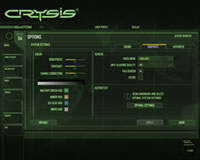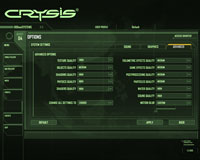Crysis
Publisher: Electronic ArtsWhat can we say about this game that hasn’t been said already? Crysis is probably the most anticipated game on the PC last year and was released on November 16th 2007.
Crysis is seen by many as the poster boy for DirectX 10 and it will make your system cry, quite literally – it’s a monster! It doesn’t come as much of a surprise then, that the graphics are something special – they’re above and beyond anything we’ve ever seen in a PC game.
We tested the game using the 64-bit executable under both DirectX 9.0 and DirectX 10 with the 1.2 patch applied. We used a custom timedemo recorded on the Harbor map which is more representative of gameplay than the built-in benchmark that renders things much faster than you're going to experience in game. We found that around 30-33 fps in our timedemo was sufficient enough to obtain a playable frame rate through the game. It's a little different to other games in that the low frame rates still appear to be quite smooth.
For our testing, we set Texture Detail, Shadows Quality, Physics Quality, Shaders Quality and Water Quality to High, while all other settings were set to medium. Because of how intense the game is, we tested with both anti-aliasing and anisotropic filtering disabled at resolutions above 1680x1050 for the time being. There is currently no support for anisotropic filtering in the game, but you can still force it from the driver control panel.
DirectX 10
Under DirectX 10 mode, the new GeForce 9800 GTX is closely matched by both the old stalwart, the GeForce 8800 GTX, and the relatively new GeForce 8800 GTS 512 that's clocked just a little lower. The difference in performance is around three to five percent, which isn't a massive amount in the grand scheme of things.
However, when you look at the results individually, you see where the card's strengths and weaknesses are. At both 1280x1024 2xAA and 1680x1050 0xAA, the GeForce 9800 GTX is 12 and 5.5 percent faster than the card its predecessor, while at 1680x1050 2xAA, it's actually around 10 percent slower than the 8800 GTX. At 1920x1200 0xAA, the two are fairly evenly matched, but neither delivers a playable frame rate.
When you look at it against the GeForce 8800 GTS 512, the GeForce 9800 GTX is always faster, but in some situations it's faster than it is in others. For example, there appears to be a bit of a rut at 1680x1050--both with and without AA enabled--and the difference is just over one percent in both instances. At both 1280x1024 2xAA and 1920x1200 0xAA, the differences are a little more respectable at 10 and 5.6 percent respectively.

MSI MPG Velox 100R Chassis Review
October 14 2021 | 15:04











Want to comment? Please log in.